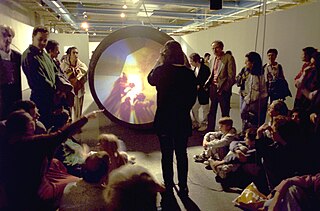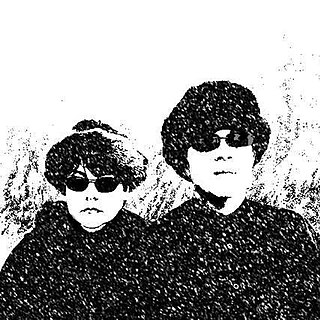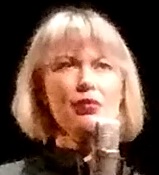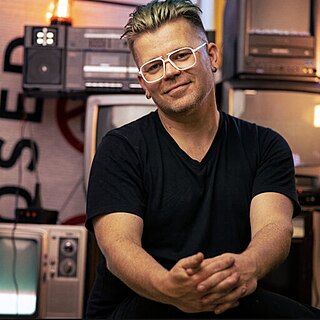
Interactive art is a form of art that involves the spectator in a way that allows the art to achieve its purpose. Some interactive art installations achieve this by letting the observer walk through, over or around them; others ask the artist or the spectators to become part of the artwork in some way.
Computer art is art in which computers play a role in the production or display of the artwork. Such art can be an image, sound, animation, video, CD-ROM, DVD-ROM, video game, website, algorithm, performance or gallery installation. Many traditional disciplines are now integrating digital technologies and, as a result, the lines between traditional works of art and new media works created using computers has been blurred. For instance, an artist may combine traditional painting with algorithm art and other digital techniques. As a result, defining computer art by its end product can thus be difficult. Computer art is bound to change over time since changes in technology and software directly affect what is possible.

Electronic art is a form of art that makes use of electronic media. More broadly, it refers to technology and/or electronic media. It is related to information art, new media art, video art, digital art, interactive art, internet art, and electronic music. It is considered an outgrowth of conceptual art and systems art.

Rafael Lozano-Hemmer is a Mexican-Canadian electronic artist living and working in Montreal, Quebec, Canada. He creates platforms for public participation by using robotic lights, digital fountains, computerized surveillance, and telematic networks. Inspired by phantasmagoria, carnival, and animatronics, his interactive works are “anti-monuments for people to self-represent.”

Rational Youth was a Canadian new wave synth-pop band that was originally active between 1981 and 1986, and at various points up until the end of 2021.

Norman White is a Canadian New Media artist considered to be a pioneer in the use of electronic technology and robotics in art.

Maurice Benayoun is a French new-media artist, curator, and theorist based in Paris and Hong Kong.
BioArt is an art practice where artists work with biology, live tissues, bacteria, living organisms, and life processes. Using scientific processes and practices such as biology and life science practices, microscopy, and biotechnology the artworks are produced in laboratories, galleries, or artists' studios. The scope of BioArt is a range considered by some artists to be strictly limited to "living forms", while other artists include art that uses the imagery of contemporary medicine and biological research, or require that it address a controversy or blind spot posed by the very character of the life sciences.

The TeleGarden was a telerobotic community garden for the Internet. Starting in the mid-1990s, it allowed users to view, plant and take care of a small garden, using an Adept-1 industrial robotic arm controlled online.
Robert Adrian (1935–2015), also known as Robert Adrian X, was a Canadian artist who made radio and telecommunications art. Adrian moved from Canada to Vienna, Austria in 1972 where he became known for creating experimental artworks using radio and communications technologies. His work The World in 24 Hours, which connected artists in different cities and continents through telephone lines and radio, is considered to be one of the first experiments in online culture. Adrian is considered to be a pioneer in the field of telecommunications art and media art.

New media art includes artworks designed and produced by means of electronic media technologies. It comprises virtual art, computer graphics, computer animation, digital art, interactive art, sound art, Internet art, video games, robotics, 3D printing, immersive installation and cyborg art. The term defines itself by the thereby created artwork, which differentiates itself from that deriving from conventional visual arts such as architecture, painting or sculpture.
Laura Kikauka is a Canadian installation and performance artist. Kikauka is known for her sculptural installations and performances incorporating found objects and electronics.

Ars Electronica Linz GmbH is an Austrian cultural, educational and scientific institute active in the field of new media art, founded in Linz in 1979. It is based at the Ars Electronica Center (AEC), which houses the Museum of the Future, in the city of Linz. Ars Electronica's activities focus on the interlinkages between art, technology and society. It runs an annual festival, and manages a multidisciplinary media arts R&D facility known as the Futurelab. It also confers the Prix Ars Electronica awards.

Tracy Howe is a Canadian musician, singer and songwriter with the band Rational Youth, and previously The Normals and Heaven Seventeen. Howe was a member of Rational Youth from 1981 to 1986 and 1997 to 2002 and 2009–2021.

Marcelo Coelho is a Brazilian American computation artist and designer. His work focuses on the boundaries between matter and computation, and includes interactive installations, photography, wearables, and robotics. Coelho is currently Head of Design at Formlabs, a Lecturer at the MIT School of Architecture and Planning and Principal Investigator at MIT's Design Intelligence Lab, a research lab inventing new forms of expression and collaboration between human and machine intelligence.

Erin Gee is a Canadian artist based in Montreal, Quebec. She is known for new media artworks and electroacoustic music composition and her art is inspired by technology and emotions, for example creating music and moving machinery inspired by recordings of heart rate and anxiety. Her works have been shown and performed internationally. Gee taught Communications as an assistant professor at Concordia University In 2018 she was an invited research associate at the University of Maine, USA in the department of chemical and biomedical engineering at University of Maine. In 2019 she began doctoral studies in music at Université de Montréal under the direction of Dr Nicolas Bernier.
Don Ritter is a visual, sound and media artist known for his interactive electronic installation works. His works of art use digital media in architectural projections, immersive video-sound installations, performances and prints. He currently lives in Montréal, Quebec.

Garnet Hertz is a Canadian artist, designer and academic. Hertz is Canada Research Chair in Design and Media Art and is known for his electronic artworks and for his research in the areas of critical making and DIY culture.

Luc Courchesne D.F.A. (1952) is a Canadian artist and academic known for his work in interactive art.
Adam Basanta is a Montreal-based artist and experimental composer whose practice investigates manifestations of technology as a meeting point of concurrent and overlapping systems. He uses various media and creates participatory and multi-sensory performances.














